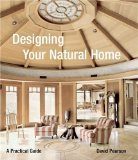
“Follow your heart”
Here’s some answers to the questions you the readers asked architect Dave Pearson, author of some seminal books on the design of eco homes.
Alec Bantos from Maine: Right now I am looking into buying a 3,049 sq ft lot in the middle of an urban downtown community in Maine. I have been researching the possibility of building a small off-grid 2 bedroom home on it and I feel no particular need to use up all of that space. My question is on how I can keep the costs down in building such a structure. What is the least I might be able to spend on this project
while making sure that it isnt a disposable or poorly built structure. Does using non-traditional building materials like shipping containers or papercrete help?
Also, I am not just excited about building my own home, but on setting an example for low-cost housing projects in general. Do you know of any architects or builders that are interested in how to build cheap, well built off-grid homes that might be able to assist in this process?
Hi Alec
To keep costs down I suggest you build small, keep it simple and consider how much you can build yourself.
Self build can save around a third of normal costs. You could look at kit homes as a possibility. They can either be delivered in parts for you to assemble or the company can assemble the shell and you finish the interior, and add the off-grid systems. But the designs may not suit your taste and they may not use eco-friendly materials.
But it will give you an idea of costs.
At the same time, I should investigate local architects. See if there’s a local chapter of the Architects, Designers, and Planners for Social Responsiblitiy (ADPSR). They should be in tune with what you want to do and could help find an architect. Or contact the American Institute of Architects (AIA). You can find these and masses of Resources in my new book ‘Designing your Natural Home’
About using non-trad. materials – a lot depends on your finance. Most mortage companies wouldn’t touch these with a bargepole and you do need to think about resale and value if you use them. But if you have the cash and make sure they meet the local building codes, maybe you can make them work.
Afterall, who would have thought straw-bale and cob would have made the grade a few years ago!
Follow the path with the heart in it and you’ll find a way, Dave Pearson
From Dennis in Norfolk: “I have an orchard and I want to build a little off-grid cabin there. I think there will be planning problems. Is there any way I can get around the planning issues?
Hi Dennis
Provided you keep you cabin below a certain size (and height) it may be able to be classed as ‘permitted development’ (like a shed or conservatory) and you won’t need to get planning permission. Your local planning office should be able to send you an explanatory booklet giving details of planning guidelines for what needs and what does not need permission.
However, if you want to live in it then it will be classed as ‘habitable accomodation’ and I expect you’ll need to get permission. You’ll also need to involve the building regs. dept.
But there is quite a market for small office/retreat buildings in the garden now and there are specialist companies who design and build these (see ads in quality newspapers and home and garden mags) and I believe they may come under ‘permitted development’.
 Designing Your Natural Home by Dave Pearson – buy it from Amazon
Designing Your Natural Home by Dave Pearson – buy it from Amazon
So if you want to build one for fun and occasional leisure use it may be OK.
Best thing is to ask the local planning office before you begin. And, remember to talk to the neighbours, especially if the cabin will affect their privacy and outlook. I’ve heard of neighbours objecting to solar panels that reflect sunlight into their windows and to wind generators that make a noise!
Anyway, good luck and I hope you make it work.
Dave Pearson
Miss Scafino in Durham NC: How does Geothermal work – can it be used
to heat an entire house?
Hi Ms Scafino
It works on the heat pump or heat exchange principal ie. you extract heat from underground earth or water and pump the heat extracted into your house.
They are most cost-effective in colder climates.
To use groundwater you will need to install a modern well that can deliver at least ten gallons an minute (gpm) to a ground-source heat pump. A flow rate of 2.5 to 3.0 gpm yields around 12,000 Btu/hr.
To gain sufficient heat from the earth you’ll need to bury about 1000 ft of two-inch polybutylene tubing four feet or more underground, filled with gycol solution, and connect each end to a heat pump. This needs quite a lot of land (maybe a acre) mostly unshaded, so is best suited for larger country lots. Its also easier and cheaper if installed as part of the construction work for a new home.
However, tens of thousands of systems have been installed in Canada and New England and other frost-belt areas.
So if this sounds of interest contact some local companies and find out what is best for your area and situation. Hope this helps.
Dave Pearson
Sandy in Nottingham – we have a south facing house and a stream in the garden – does that mean we could live completely off the grid?
Hi Sandy
Well it sounds as if you’ve the making of a good off-grid home. With south-facing aspect you can make to most of passive solar gain from windows and glazed sunspaces. It’s also excellent for siting PV and solar hot water panels.
The stream may be good for generating hydro-electricity. But it depends on a number of factors. So not to repeat myself, here is an extract from my latest book ‘Designing your Natural Home’.
“Hydropower
If you are fortunate enough to have the right site, hydroelectricity is an attractive renewable energy choice. In ideal conditions, it can be cheaper than a PV system of comparable output. So what is a good site? It all depends on water volume/weight and its fall or ‘head’. You can achieve the same output from a small volume of water falling a large distance as a large volume falling a small distance. The former situation – small spring/large fall – is better for your ‘micro-hydro’ system as it will be smaller and cheaper to build. Find out if there are daily flow figures for the past 5 – 20 years available to check how dependable the supply is over the year.
Apart from a site’s potential energy output, other aspects may have to be considered such as the effect on fish and aquatic wildlife, riparian rights, environmental conservation, recreation activities, land drainage, flood defence, trees, public access and building control. Approach the local river authority early, make friends with them, and seek their advice. You will probably need a licence from them anyway. Also check upstream obstructions and ‘abstractions’ (diversion of water) or ‘impoundments’ (a weir or sluice, for example). This all sounds a bit formidable, but if this is going to be your main source of power, you need to be certain of the feasibility before you jump in and buy the land. In fact, the site of an old or disused water mill may well suit all these conditions and, if converted using modern equipment, can make an ideal hydropower project, and perhaps even double as your natural home too!
The basic parts are: supply pipeline (‘penstock’), turbine, alternator/generator, regulator, wiring and controls. With the constant output from hydropower, it is best to be grid linked rather than having to use battery storage. If you are using hydropower in conjunction with PV and wind turbine systems, you can feed all sources into your central battery and DC/AC inverter/control units or, again, be grid linked. Every site is different, so seek expert technical advice at the earliest stage.”